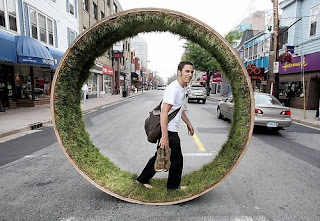Having spent last semester developing an unusual obsession with subways, the idea of revisiting the subject was not too painful. The subject of crime was my original starting point, I discussed the “Broken Windows” theory as talked about in “The Tipping Point” by Malcolm Gladwell (p141) which, in very simple terms, suggested that if a window is broken and not repaired, people passing by will decide that no one cares and that no one is managing the area. Soon, more windows will be broke
n, and the feeling of chaos and mayhem grows. Especially in a city, comparatively small problems like graffiti or public disorder are the equivalent of broken windows, a temptation to more serious crime. The atmosphere created in a confined and isolated space, such as an underground station, dictates a passengers feeling of safety and in turn, their likelihood of being a returning customer.
In order to research the pros and cons of subway atmosphere last semester, I spent a great deal of time, through books and internet sites, researching the most famous subway stations of the world and how they function at present. I did the same to get a better idea of how atmosphere can be affected by architecture. This topic grew arms and legs as many factors play a part in creating the atmosphere in a space.
Having previously been anti-mind-mapping, I reluctantly completed one on this topic as part of an assignment in semester one. Annoyingly, I found the mind-map extremely useful as a way of documenting and organising my thoughts.

This threw up many issues and ideas surrounding subway atmosphere. In order to take this research further it is now clear, having completed this semesters assignments, that primary research techniques are key to discovering the public’s needs. The underground system is of course a public transport service and so who better to look to to answer the question, “how do we improve the atmosphere in our underground stations?” than the public?
Most subway systems tend to be filthy and rather dull aesthetically. But there are cities that explicitly foster arts and good architecture in subways. Works of art or sophisticated architecture can be inspiring and thought-provoking for daily commuters as well as an attraction for visitors. Distinctive colour schemes and works of art help passengers for orientation. Furthermore, there is evidence that vandalism diminishes in appealing stations because works of art and good designs are widely respected.
Observation would be my key form of primary research here. So much can be discovered just by watching people, but not just watching aimlessly, by really observing their body language and behaviour and in this case their movement patterns, speed of movement, interaction, age, sex etc... Gathering this information to discover the patterns of behaviour would be invaluable to ascertain how the public use stations. The present design and decoration of each station would have to be considered as these factors would effect their behaviour. Observation would highlight the problems and possible good points of the existing stations. To develop the data gathered from such observations, an experiment could be arranged to temporarily alter the atmosphere of the station, for example, the lighting could be changed or a variety of music played to see if behaviour changes. In the London Underground was said to play fast marching music during the morning rush, and calm relaxing music in the evening rush - the first to get people moving, the second to calm them down.
A series of focus groups of regular commuters, combined with a small visual experiment could prove useful as an insight into what commuters would like to see happen to their stations. I this think would prove more effective than interviewing individual commuters as a discussion tends to throw up more interesting results and the idea of trying to get a commuter to stop and answer questions fills me with fear! Various stations around the world have instigated innovations in an attempt to improve their commuters daily experience, such as Moscow Metro’s mobile art exhibition. Perhaps a discussion surrounding the various innovations around the worlds subways would show up a particular favourite, an area which needs improving and possibly a solution. Involving regular commuters who can take the time to converse with other commuters should throw up the real problems they experience daily and what they would like to see done about it.
Our underground stations are ever changing and improving, with the addition of interactive technology as one example. TFL (Transport for London) will be investing capital into the renovation of the Underground network in preparation for the 2012 Olympic Games. In a private venture, CBS Outdoor (a leading outdoor advertising company) are investing £72 million over the next two and a half years to improve every single advertising site on the Underground including installation over 2000 digital sites. These days advertising seems to be playing a huge part in creating a stations atmosphere, keeping things interesting and stimulating. So with all this money flying around to invest in this country’s largest underground system lets hope that they have used their primary research to talk to the public, the people who will be using this service. Here is an example of some advertising in a Tokyo subway tunnel. This particular technology, brought to my attention by Jonathan Baldwin, uses the old-fashioned zoetrope device as its inspiration. A zoetrope is a device that produces an illusion of action from a rapid succession of static pictures.
Bibliography
Bennet, D, (2004), Metro the story of the underground railway, London, Octopus Publishing
Gladwell, M, (2000), The Tipping Point, Great Britain, Abacus
http://hoocher.com/Hans_Makart/The-Senses_1879.jpg
Lepori, R, and Franck, K, (2007), Architecture from the Inside Out, Great Britain, Wiley-Academy
Preston, J, (2004), Interior Atmosphere, London, Artmedia Press
http://www.youtube.com





